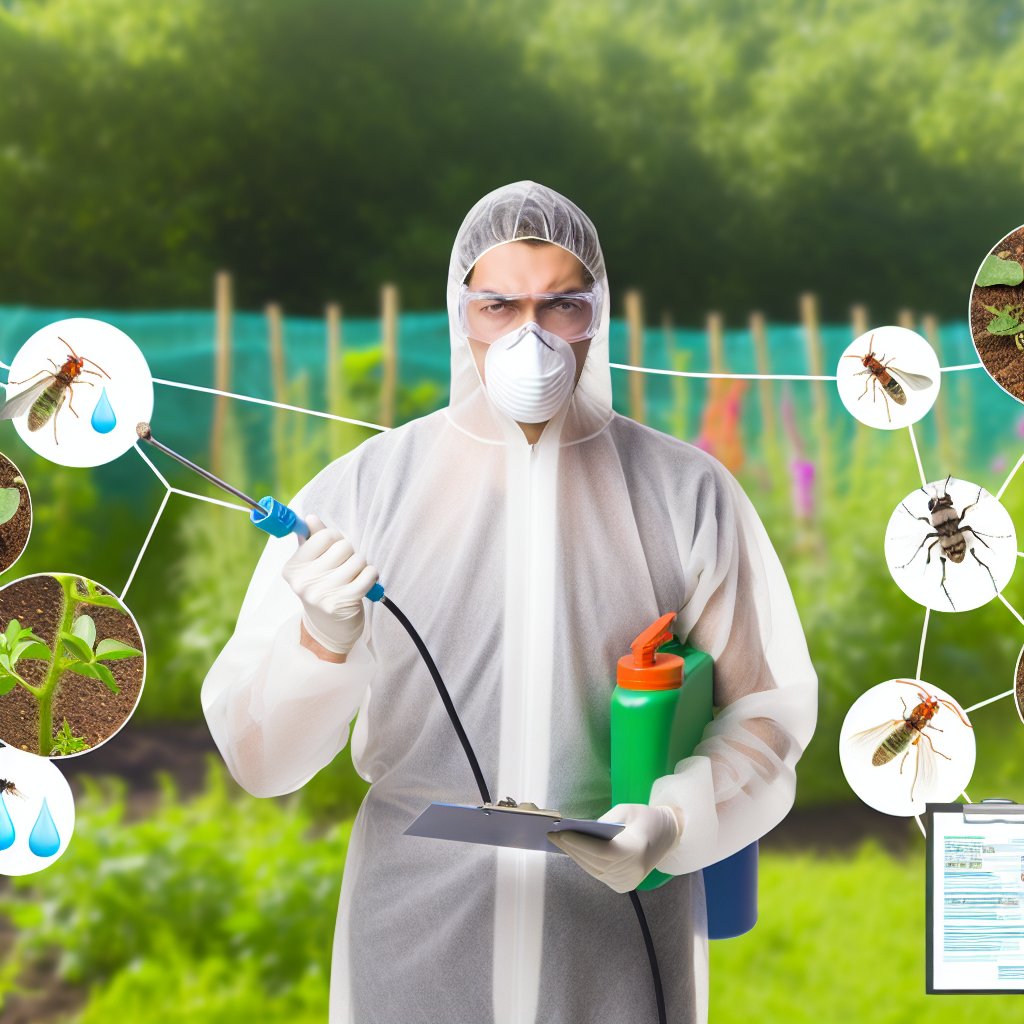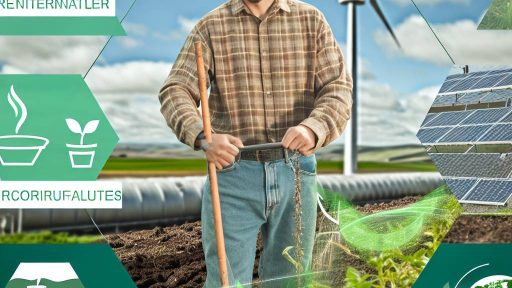Overview of Integrated Pest Management and its Importance in Agriculture
Defining Integrated Pest Management
Integrated Pest Management (IPM) combines various management strategies.
It aims to control pest populations effectively and sustainably.
The approach considers cultural, biological, and chemical methods.
Furthermore, it emphasizes the importance of environmental health.
Importance of IPM in Agriculture
IPM plays a crucial role in modern agriculture.
It helps farmers reduce pesticide use and costs.
This method minimizes environmental impacts related to pest control.
Additionally, IPM enhances crop yields by maintaining crop health.
Benefits of Implementing IPM
- Improved pest control efficiency.
- Reduced risk of pesticide resistance.
- Enhanced biodiversity on farms.
- Lower input costs for farmers.
- Safer food products for consumers.
Components of IPM
IPM includes several key components.
Firstly, monitoring pest populations is essential.
Secondly, implementing preventive practices can reduce pest incidence.
Additionally, employing biological control methods is beneficial.
Lastly, using pesticides is only a last resort.
Environmental Benefits of IPM
Reducing Chemical Pesticide Use
Integrated Pest Management, or IPM, drastically reduces chemical pesticide usage.
This approach emphasizes monitoring and understanding pest populations.
Transform Your Agribusiness
Unlock your farm's potential with expert advice tailored to your needs. Get actionable steps that drive real results.
Get StartedBy doing so, it limits unnecessary chemical applications.
Farmers can use targeted treatments instead of blanket sprays.
This significantly lowers the amount of toxic substances released into the environment.
In addition, reduced pesticide use helps protect non-target organisms.
This includes beneficial insects and pollinators vital to ecosystem health.
Moreover, IPM fosters improved soil and water quality.
Chemical pesticides can leach into waterways and harm aquatic life.
Less reliance on these chemicals decreases the risk of water contamination.
Transitioning to IPM also lowers the chances of developing pesticide-resistant pests.
Resistant pests can lead to increased chemical usage over time.
Thus, integrating sustainable practices can ensure pest control remains effective.
Furthermore, IPM practices often promote biodiversity on farms.
By creating more balanced ecosystems, farmers support natural pest control methods.
Overall, reducing chemical pesticide use plays a crucial role in IPM.
This method addresses environmental concerns while maintaining agricultural productivity.
As a result, both farmers and consumers benefit from healthier ecosystems.
Economic Advantages
Cost Savings from Efficient Pest Control
Integrated pest management (IPM) strategies significantly reduce pest control costs.
This approach minimizes the reliance on expensive chemical pesticides.
Instead, IPM utilizes a combination of natural predators and monitoring techniques.
Consequently, farmers experience less crop damage from pests.
As a result, this leads to increased yields and higher profit margins.
Moreover, implementing IPM reduces labor costs related to pesticide application.
Farmers require fewer applications, saving both time and resources.
In addition, reduced chemical inputs lower overall operational costs.
Showcase Your Farming Business
Publish your professional farming services profile on our blog for a one-time fee of $200 and reach a dedicated audience of farmers and agribusiness owners.
Publish Your ProfileThis fosters sustainable farming practices and enhances environmental health.
IPM also protects beneficial insects, aiding in natural pest control.
This dynamic contributes to maintaining a balanced ecosystem.
With fewer chemical residues, products are safer for consumers.
Such practices can improve a farm’s marketability and brand image.
Further, government incentives may offer financial aid for adopting IPM.
Transitioning to these techniques can yield long-term savings.
IPM strategies lead to substantial cost savings for farmers.
Delve into the Subject: Complying With Import Export Regulations In Modern Farming
Impact on Human Health: Minimizing Pesticide Exposure Risks
Understanding Pesticide Risks
Pesticides play a significant role in agriculture today.
While they protect crops, they can also pose health risks to humans.
Excessive exposure to pesticides has been linked to various health problems.
These include respiratory issues, skin irritations, and neurological disorders.
Integrated Pest Management Overview
Integrated Pest Management (IPM) is a holistic approach to pest control.
It focuses on sustainable practices to minimize harm.
IPM strategies reduce reliance on chemical pesticides.
This helps to protect human health significantly.
Reducing Chemical Use
IPM encourages the use of natural predators to control pest populations.
This method helps maintain ecological balance in agriculture.
Additionally, IPM promotes cultural practices like crop rotation.
These practices further decrease the need for harmful chemicals.
Benefits of Lower Pesticide Exposure
Lower pesticide exposure leads to improved human health outcomes.
It reduces the risk of chronic diseases related to pesticide use.
Moreover, it can diminish the incidence of acute poisoning cases.
Children, the elderly, and pregnant women are particularly vulnerable.
Protecting these groups is essential for community health.
Community Awareness and Education
Raising awareness about pesticide risks is crucial.
Community education programs can encourage IPM adoption.
Knowledge empowers individuals to make safer choices.
Furthermore, education fosters support for healthier agriculture practices.
Communities benefit from a stronger connection to sustainable farming.
Delve into the Subject: Comprehensive Overview of Agricultural R&D Funding Opportunities for Farmers
Enhancing Biodiversity: Promoting Beneficial Insects and Ecosystems
The Importance of Biodiversity
Biodiversity is essential for a healthy ecosystem.
It supports the resilience of agricultural systems.
Moreover, it helps to maintain ecological balance.
Beneficial Insects and Their Roles
Beneficial insects play a crucial role in pest control.
They include pollinators, predators, and parasitoids.
For instance, ladybugs consume aphids.
This natural predation reduces the need for chemical pesticides.
Creating a Welcoming Environment
Farmers can promote beneficial insects through habitat management.
Showcase Your Farming Business
Publish your professional farming services profile on our blog for a one-time fee of $200 and reach a dedicated audience of farmers and agribusiness owners.
Publish Your ProfileThey should incorporate flowering plants around crops.
These plants provide food and shelter for beneficial insects.
Utilizing Cover Crops
Cover crops enhance biodiversity in agricultural systems.
They can attract beneficial insects during off-seasons.
Additionally, cover crops improve soil health.
Implementing Crop Rotation
Crop rotation increases biodiversity by varying plant families.
This practice disrupts pest life cycles.
As a result, it reduces pest populations naturally.
Implications of Biodiversity Enhancement
Enhancing biodiversity through integrated pest management provides numerous benefits.
These benefits include increased ecological balance and healthy pest control.
Ultimately, it leads to sustainable agricultural practices.
Delve into the Subject: Food Safety Certification Processes for Farmers

Long-term Sustainability: Building Resilience in Agricultural Systems
Understanding Integrated Pest Management
Integrated Pest Management (IPM) offers a sustainable approach to pest control.
This strategy combines various management practices to control pests effectively.
Farmers adopt IPM to minimize reliance on chemical pesticides.
Consequently, this method enhances farm resilience over time.
Enhancing Soil Health
Healthy soil forms the foundation of sustainable agriculture.
IPM practices often promote organic matter and microbial diversity in the soil.
Improved soil health directly contributes to better crop yields.
Thus, managing pests through IPM supports ecosystem health.
Promoting Biodiversity
Biodiversity plays a crucial role in resilient agricultural systems.
IPM encourages the use of natural predators to manage pests.
This reduces the need for synthetic chemicals while promoting species variety.
Additionally, diverse ecosystems help control pest populations naturally.
Reducing Chemical Dependency
One of the main benefits of IPM is reduced chemical usage.
Farmers employ alternative methods like biological controls and traps.
As a result, this approach decreases harmful runoff into water systems.
Furthermore, it lowers the risk of pesticide resistance in target pest species.
Economic Viability
IPM can lead to cost savings for farmers in the long run.
By integrating multiple pest management strategies, farmers reduce input costs.
Moreover, healthy crops yield better, improving overall profits.
This economic viability encourages more farmers to adopt sustainable practices.
Community Engagement and Education
Effective IPM involves community awareness and education initiatives.
Workshops and training enhance knowledge of sustainable practices.
Engaging local farmers creates a collective effort against pests.
Ultimately, shared information leads to stronger regional agricultural resilience.
Learn More: Maximizing Farm Potential Through Effective Rural Development Policies
Case Studies: Successful Implementation of IPM Strategies
Case Study: Green Acres Farm
Green Acres Farm in Ohio adopted an Integrated Pest Management approach in 2021.
The farm faced significant challenges with aphid infestations.
Initially, they used chemical pesticides extensively.
Showcase Your Farming Business
Publish your professional farming services profile on our blog for a one-time fee of $200 and reach a dedicated audience of farmers and agribusiness owners.
Publish Your ProfileHowever, these methods led to resistant pest populations.
Consequently, the farmers shifted to IPM strategies for long-term solutions.
They started by monitoring pest populations regularly.
This practice allowed them to assess the need for intervention accurately.
Next, they implemented biological control measures.
Beneficial insects, such as ladybugs, were introduced to the fields.
This natural predation effectively reduced aphid numbers.
Moreover, they rotated crops annually to disrupt pest lifecycles.
The results were impressive, with a 40% reduction in pest damage.
Ultimately, this shift led to higher crop yields and healthier soil.
Case Study: Urban Garden Initiative
The Urban Garden Initiative in Seattle aimed to promote sustainable urban agriculture in 2020.
Residents often faced challenges with common pests like slugs and snails.
They began implementing IPM practices to address these issues.
First, they encouraged organic gardening methods among participants.
Members learned about the importance of planting native species.
These plants attract natural predators and pollinators.
Next, the initiative promoted handpicking pests as a control strategy.
Participants reported significant reductions in pest populations.
They also utilized barriers, such as copper tape, to protect vulnerable plants.
This approach proved cost-effective and environmentally friendly.
As a result, community members enjoyed bountiful harvests.
The initiative fostered a sense of community and environmental stewardship.
Case Study: Orchard Revival Project
The Orchard Revival Project in California aimed to restore aging fruit orchards.
The orchards suffered from various pests including codling moths.
Farmers used IPM strategies to tackle these ongoing challenges.
They began with regular field inspections to monitor pest activity.
Next, they implemented pheromone traps to disrupt mating cycles.
Additionally, they introduced beneficial wasps to control pest populations.
Farmers also focused on maintaining orchard health through soil management.
Improved soil vitality boosted tree resilience against pest attacks.
As a result, the project led to healthier fruits and increased marketability.
This case study showcases the effectiveness of IPM in diverse settings.
Challenges and Solutions in Adopting Integrated Pest Management Practices
Understanding the Main Challenges
Farmers face various challenges while implementing Integrated Pest Management (IPM) strategies.
One significant issue is the lack of knowledge and training in IPM practices.
Many farmers are accustomed to traditional methods, causing resistance to change.
Additionally, financial constraints can limit the adoption of newer technologies.
Lastly, environmental factors often complicate IPM strategies in different regions.
Addressing Knowledge Gaps
Education plays a crucial role in overcoming knowledge barriers.
Workshops and training sessions can help farmers understand IPM benefits.
Collaboration with agricultural extension services can facilitate knowledge transfer.
Showcase Your Farming Business
Publish your professional farming services profile on our blog for a one-time fee of $200 and reach a dedicated audience of farmers and agribusiness owners.
Publish Your ProfileMoreover, government and non-profit organizations can provide essential resources.
Online platforms can also host valuable information and tutorials on IPM practices.
Financial Solutions for Farmers
Financial support is vital in adopting IPM strategies effectively.
Government grants and subsidies can ease the initial investment burden.
Additionally, flexible financing options can make it easier for farmers to invest.
Moreover, cooperative purchasing can reduce costs for farmers collectively.
Insurance programs can also protect against potential crop losses during transition periods.
Adapting to Environmental Variability
Environmental challenges require adaptive strategies in IPM practices.
Farmers should perform regular assessments of local pest populations.
Utilizing climate data can help in planning pest control measures effectively.
Moreover, integrating local ecological knowledge can enhance IPM strategies.
Lastly, developing weather-resistant crop varieties can improve resilience.
Building Community Support
Community involvement is crucial for the successful rollout of IPM strategies.
Peer support groups can encourage knowledge sharing among farmers.
Community forums can facilitate discussions on challenges and solutions.
Moreover, local agricultural fairs can showcase successful IPM implementations.
By fostering a culture of collaboration, communities can enhance overall agricultural sustainability.
Additional Resources
NATIONAL ROADMAP FOR INTEGRATED PEST MANAGEMENT …
Agricultural Pesticides: Management Improvements Needed to …




